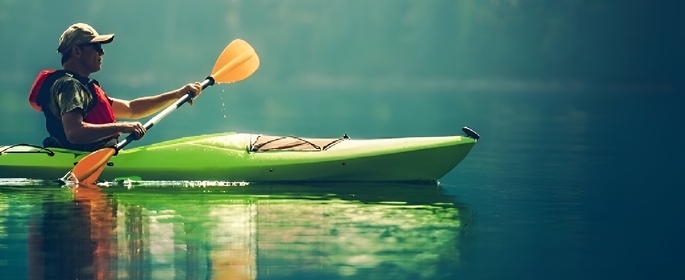Author: PaddleZone Date Posted:5 April 2024
.jpg)
Now is the perfect time to purchase a new kayak and check out some amazing paddling accessories. The good news? You have more options from a wider range than ever before. Whether you’re paddling for sport, exercise, competition or adventure, there are countless kayak brands, models and sizes available.
Throughout this article, we are going to focus on two of the most popular kayaks: sit-on and sit-in. While the difference may seem simple on the surface, these two styles are actually more varied and distinctive than meets the eye.
From comfort to speed, design, stability and more, this guide will cover everything you need to know about sit-on and sit-in kayaks.
Sit-On and Sit-In Kayaks - The Basics
At first glance, the major difference between the two is the structural design, as well as the way that you are positioned and seated. If you’re in the market for your very first kayak, we recommend familiarising yourself with both before making a purchase.
Sit-On
Sit-on or ‘sit-on-top’ kayaks have an open cockpit design that makes getting in and out of the kayak incredibly simple. Ease of access onto and off the kayak are a key advantage for the paddler. The main components of a sit-on kayak are the deck, hull, bow and stern, with easy to access seating positioned in the centre or at opposite ends (for tandem/double kayaks).
Here, the paddler is positioned at surface level or above the water. Known for being literally unsinkable, sit-ons are one of the most popular choices for beginners and fishers alike. In fact, many recreational kayaks come with a sit-on-top design.
Most sit-on kayaks are not supplied with a rudder for steering, however have a well balanced hull shape to assist with tracking or direction when paddling. Your paddle stroke (left and right) determines the direction you will go. A stronger stroke on either side will enable the kayak to travel in that direction, an even left and right stroke will keep the kayak centred.
Overall, this style is perfect for summer, fishing, recreational and casual paddling or anyone wanting to learn how to kayak.
Sit-In
Sit-in or ‘sit-inside’ kayaks have an enclosed cockpit that allows the user to place their legs comfortably under the front deck. With support on both sides, this setup offers extra protection against the wind, water spray, and UV rays. Once inside, the paddler also has a lower centre of gravity than a sit on top kayak.
Sit-in kayaks are generally heavier than sit-on kayaks and are ideal for recreational paddling and touring. In each case, the enclosed cockpit can make for a great place to store your equipment and supplies as most sit-in kayaks come with a sealed or waterproof area known as a bulkhead, for storage. This is why paddlers often choose sit-insides for longer trips and kayaking adventures.
Due to their sleek narrow design, sit-in kayaks are typically faster, easier to manoeuvre, to control, and are more stable when turning.
Key Differences
Let’s outline the key differences between the two kayak types and their significant impact on their performance on the water.
Speed and Performance
In comparison to sit-on-tops, sit-in kayaks get a gold star for performance and speed. With your feet, knees and thighs snug and secure within the kayak, it’s like wearing running shoes instead of sandals. Its narrower design and length means the kayak travels faster through the water.
Ultimately, your choice between sit-on and sit-in kayaks should be based on the specific kayaking journeys you have in mind. If you prioritise faster paddling and more control, a sporty sit-inside kayak may be the ideal choice for your adventure.
Comfort
Sit-on kayaks champion comfort, mobility, and manoeuvrability. A sit-in can limit movement, whereas a sit-on-top includes a platform that is simple to shift around on. With freedom of leg movement, a sit-on can be considered to be more comfortable with different seats available. Sit-ons offer adjustable seats for flexibility, but the comfort of the kayak, all in all, depends on the preferences of the paddler.
Looking for a luxurious way to relax? Here are quality kayak seats and backrests to keep you comfortable while paddling.
Weight Capacity
Kayaks have different weight capacities, and in this case, the decision depends on the paddler’s mass and what gear they may be paddling with. A sit-in generally has a lower weight capacity, whereas a sit-on can carry more weight and gear as it's often a wider kayak and above the water line.
When tossing up between a sit-on or sit-in, it's also important to consider how and where you plan to use the kayak. Are you planning leisurely paddling on calm lakes or rivers or are you gearing up for a fishing expedition, camping trip, or other outdoor adventures? This will all play a part in your decision making.
The kayak's weight capacity directly impacts your ability to bring along essential equipment and supplies. Assessing your needs and matching them with the kayak's weight capacity will ultimately help you select the perfect model.
Stability
Both kayak types are stable in their own ways and overall stability depends on the paddler’s experience or ability, the height of the seat, the width and length and the kayak's hull shape.
If stability is your end goal, a sit-on-top is ideal for anglers and recreational paddlers due to the kayak’s width, hull shape and overall design. If your aim is performance, sit-in kayaks have edge stability and can be leaned onto their edges with ease. Ultimately, sit-on types suit flatter waters, whereas sit-ins are excellent in more challenging water conditions.
Primary stability. This is the stability of the kayak when it is at rest on calm water. Wider kayaks have improved stability as more of the hull surface area is in the water.
Secondary stability. Secondary stability refers to the stability of the kayak when it is leaning to one side while turning or edging. Narrow kayaks that are more V-shaped in the hull are an example of high/low secondary stability, since the centre of gravity is much lower than in wider kayaks.
Bracing. Bracing relates to when you push your feet against the pedals or legs against the inside of the kayak. Some sit in kayaks are supplied with thigh braces to increase bracing effectiveness and the kayak's performance.
Design
Length and width both influence the performance of sit-on and sit-in kayaks. A wide sit-on kayak is a more stable ride, whereas a narrow, longer, sit-in will paddle faster.
Sit-on kayaks often have a more open and exposed design. They typically feature a flatter and wider deck, and the paddler is visible sitting on top of the kayak. These kayaks may have moulded contours, deck fittings, and on deck storage areas that are visible and easily accessible. Sit-ons often come in vibrant colours and are designed with a focus on stability, accessibility, practicality and user-friendliness, rather than a sleek or traditional kayak appearance.
Sit-in kayaks, on the other hand, tend to have a more streamlined, sporty and enclosed appearance. The paddler's legs are concealed inside the cockpit, giving the kayak a sleeker profile. They may have a narrower width and a more traditional kayak shape. These kayaks often come in a variety of lengths, colours and designs, and their appearance can be influenced by their intended use, whether for touring, whitewater, sea kayaking, or recreational paddling.
At Paddlezone, we stock a great range of kayaks for sale in Sydney, Melbourne, Newcastle and the Gold Coast.
Storage and Portability
While sit-on kayaks are always going to win the storage wars, sit-in kayaks are usually longer and often heavier. If storage is important to you, consider the following factors.
Gear Quantity: Determine how much equipment you need to take with you.
Waterproof Needs: Decide if it's essential to keep your gear dry during your trip.
Item Size and Shape: Take into account the dimensions and forms of the items you plan to carry.
On-Water Access: Consider what items you'll need easy access to while paddling.
In a sit-in kayak, storage is confined within the hull, which shields your gear from the elements. However, the challenge lies in fitting everything through limited hatch openings or spaces between your legs. This setup is suitable for clothing and camping gear, but may pose difficulties for accommodating bulky items. On deck storage is usually a dry bag attached to the deck fittings. Water-proof or dry bags are available and a great solution for items such as cameras or items that should not get wet.
On the flip side, a sit-on-top kayak offers more versatile storage solutions. Most sit-on-tops feature a spacious hatch at the stern, which works great for kayak cooler bags and larger items. The inherent stability of sit-on-tops simplifies movement for accessing items while out paddling. However, it's worth noting that this openness exposes your gear to wind, sun, waves and rain. Some sit-on-tops offer small dry-storage compartments, but you may need additional dry bags to safeguard clothing, electronics and valuables from moisture.
Finding Your Perfect Kayak
- Sit-on-top kayaks are user friendly and ideal for beginners who want peace of mind on the water, recreational paddling that is stable, yet fast, or kayaks that are easy to enter or exit.
- Sit-in kayaks are ideal for paddlers who aim for longer and even multi-day trips, performance, and river or ocean paddling. Both kayak types have benefits depending on your individual needs on the water.
Of course, the best way to narrow down your options is to identify how and where you'll be using your kayak. Consider the following:
- Will you be paddling on a sheltered body of water or more exposed waterways?
- Will the water be warm enough to swim in?
- Are you looking for a kayak that can travel quickly or are you more concerned about having a very stable boat that will be difficult to tip over?
Interested in different ways to explore the water? Check out all of the kayaks and stand-up paddle boards for sale at PaddleZone.
Tips for Beginners
- Kayak on calm waters if you're a beginner. For a safer experience, don’t kayak across open rough water. Start in calm flat conditions.
- Always dress for the water, not the weather. A sit-in kayak is often used in colder conditions and cold water, so warmer clothing is recommended. As for warmer conditions and warmer waters, lightweight, quick dry clothing is recommended.
- Always prioritise safety. Kayaking can be a high-intensity activity, so there are safety protocols to ensure your safety. For example, kayaks have the potential to roll, so always paddle in conditions that suit your ability. Lessons or paddling with a group is an option too.
- Adjust the kayak on dry land. A kayak may have adjustable seats or footrest pegs. Making these adjustments while on the water can be difficult, resulting in it rolling. So it is best to make any changes to the kayak while on land or in shallow water before heading out.
- Be familiar with the type of paddling styles. Learning different strokes is essential, such as the forward stroke, backward stroke, reverse stroke, sweep stroke, and draw stroke.
As Australia’s home for all things paddling, the Paddlezone team can answer any questions you have about sit-on or sit-in kayaks.
What About Kayak Safety?
It doesn't matter how many years of experience you hold, paddler safety is our number one priority.
- Always paddle to your kayaking skills and limitations on the water. If you're uncertain, don't push yourself.
- If the weather forecast is not suitable to your paddling capabilities, don’t go
- Ideally paddle with someone else or at least tell someone your paddling plans.
- Always wear PFD’s and life jackets when on the water, even if you're a competent swimmer and paddler, in most states, it’s the law.
- Always use common sense. If something doesn't feel right, turn back.
Are Inflatable Kayaks an Option?
Absolutely! If you're looking for a comfortable way to paddle, inflatable kayaks across Melbourne can be rolled up, folded, deflated, transported and stored with ease. Although they aren't as fast as rigid kayaks, they are versatile and user-friendly.
Kayaks for Sale in Australia - Explore Our Range Today
Whether you're a beginner or have years of experience, it is always important to find a trustworthy and reliable paddle sports store. If you want to explore waterways near you or a long way from home, touring kayaks, recreational kayaks, a single sit-on-top kayak, sea and expedition kayaks, SUP for sale, are all available.
PaddleZone has dedicated kayak shops in Melbourne, Sydney, Gold Coast, Newcastle, and online shopping for customers across Australia. Contact us today for a personalised quote to get you paddling on your next adventure!


